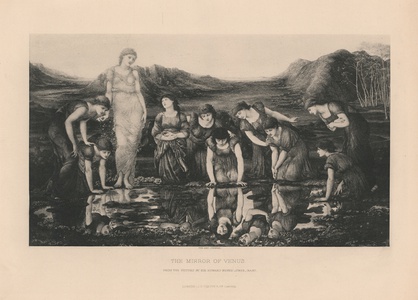| Method | Photogravure |
| Artist | After Sir Edward Coley Burne-Jones |
| Published | London J.S. Vertue & Co. Limited. [c. 1900] |
| Dimensions | Image 151 x 257, Sheet 248 x 323 mm |
| Notes |
From the 'Art Journal'. The 'Art Journal' originally opposed the emerging Pre-Raphaelite Brotherhood, with its articles attacking the the movement and its supporter, John Ruskin. When the editor, Samuel Carter Hall, retired in 1880, the 'Art Journal' changed its stance. In the latter half of the nineteenth-century, the idea that art should be a separate entity to literature was gaining force. It was at this time when the rhetoric of art for art's sake was most fiercely debated, and artists such as Rossetti replaced previously literary titles with simple designations. In the 'Mirror of Venus', not only is the quattrocento evoked, but so too are Burne-Jones' philhellenistic tastes as the figures in the work wear classical garments, and appear in a linear frieze-like manner of Grecian manner. The title, however, is somewhat deceptive. Though Burne-Jones was an extensive reader of Classics, the scene conjured in this work is an imaginary one. As in 'The Golden Stairs', the artist's interests look as if they lie in the investigation of mood as opposed to the display of a narrative. The wistful, oneiric girls, a huge influence to artists such as Marie Spartali, may just have been an exaltation of ideal beauty; as alluded to in the title. Sir Edward Coley Burne-Jones, 1st Bt (1833-1898) was a painter and designer closely associated with the later phase of the Pre-Raphaelite movement. Burne-Jones met William Morris as an undergraduate of Exeter college, Oxford, whilst studying for a degree in theology. The pair went on to work very closely together on numerous decorative arts projects including stained glass windows, tapestries and illustrations. Originally intending to become a church minister, Burne-Jones never finished his degree, choosing instead to pursue an artistic career under the influence of Dante Gabriel Rossetti. Rossetti heavily inspired his early work, but by the 1860's his idiosyncratic style was beginning to develop. His mature work, however different in total effect, is rich in conscious echoes of Botticelli, Mantegna and other Italian masters of the Quattrocento. Thusly, Burne Jones' later paintings of classical and medieval subjects are some of the most iconic of the Pre-Raphaelite movement. He was at the height of his popularity during the 1880's, though his reputation began to decline with the onset of the Impressionists. He was created a baronet in 1894, when he formally hyphenated his name. |
| Framing | mounted |
| Price | £125.00 |
| Stock ID | 52205 |

